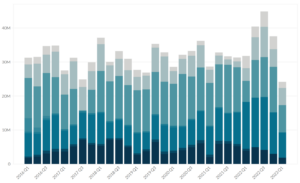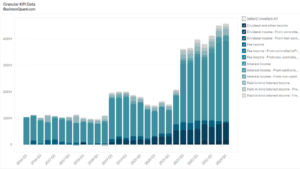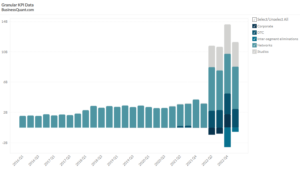
Taiwan Semiconductor’s 7nm, 5nm, 3nm Wafer Revenue (2010-2023)
Exclusive Data
You need the Pro Plan to access KPI data
- Full access to the platform
- KPI data & segment financials on US stocks
- Financial data on thousands of stocks
- Download data in xlsx and csv formats
Pro Plan
$49 per month*
60% discount ends in:
.
About
More information
Subscribe to Pro or Enterprise plans to unlock this feature.
Contact the Analyst
Subscribe to Pro or Enterprise plans to unlock this feature.
Become a smarter investor today.
Access KPIs & Segment Financials on US stocks
This statistic highlights Taiwan Semiconductor’s Wafer Revenue Breakdown, across 14nm, 10nm, 7nm and 5nm, reported on a quarterly basis from Q1 2010 onwards.
Taiwan Semiconductor Manufacturing generated 8% and 35% of its wafer revenue from 5nm and 7nm process nodes in Q3 2020.
Taiwan Semiconductor’s wafer revenue increased by 14.7% QoQ during Q3 2020. The growth can be attributed to the spike in demand for their advanced technologies and specialty technique solutions. Taiwan Semiconductor had also rolled out its most advanced 5-nanonemeter (or 5nm) fabrication process during the year which became a significant revenue driver, very quickly.
As of Q3, TSMC’s 5nm process accounted for 8% of the company’s overall wafer revenue — a commendable feat considering the new node just debuted. As we process nodes continue to shrink in the cutthroat semiconductor industry, the 5nm node is likely to drive higher revenue for the company in the coming quarters.
Besides, TSMC’s 16nm resolution and smaller nodes collectively accounted for 61% of its total wafer revenue during Q3 2020. Taiwan Semiconductor uses wafers of various resolutions in various fabrication processes now, which include 5nm, 7 nm, 10 nm, 16 nm, 20 nm, 28 nm, 40/45 nm, 65 nm, 90 nm, 0.11/0.13 micron, 0.15/0.18 micron, and more than 0.25-micron resolutions.
| Wafer Resolution\Period | Q3 2019 | Q2 2020 | Q3 2020 |
| 5nm | 0% | 0% | 8% |
| 7nm | 27% | 36.41% | 35% |
| 10nm | 2% | 0.26% | 0% |
| 16nm | 21.6% | 17.69% | 18% |
| 20nm | 0.8% | 0.81% | 1% |
| 28nm | 15.7% | 13.98% | 12% |
| 40/45nm | 9.7% | 9.46% | 8% |
| 65nm | 7.4% | 5.66% | 5% |
| 90nm | 2.5% | 2.77% | 2% |
| 0.11/0.13um | 2.5% | 2.75% | 2% |
| 0.15/0.18nm | 8.6% | 7.86% | 7% |
| 0.25um+ | 2.2% | 2.35% | 2% |
TSMC’s two-year old 7nm process node accounted for a significant 35% of the company’s total wafer revenue, making it the highest contributing process node for the foundry. Since the Q4 2018, 7nm chips have accounted for the largest and an increasing share of wafer revenue for TSMC. These 7nm chips are present in various devices, including but not limited to, PCs, smartphones, tablets, data centers, and vehicles and some of the company’s largest customers happen to be Apple, Nvidia and AMD (Advanced Micro Devices).
However, with the introduction of the 5nm chips, we can expect a shakeup in its node market share in favor of this new entrant. Over the quarters, the 16nm and 28nm nodes have lost their share to the 7nm nodes – a trend that’s especially been prevalent since Q4 2018. We can expect a similar fate for the 7nm, only that it’ll likely lose its prominence to 5nm and 3nm fabrication technologies.
For the record, Taiwan Semiconductor’s 7nm wafer revenue grew 10.27% QoQ and 61.25% year-on-year. Its management announced that they were able ramp production for 7nm manufacturing process at the fastest pace in the company’s history, compared to all the preceding nodes.
From a competitive standpoint, Taiwan Semiconductor’s 7nm chips is an advanced fabrication process and only two other foundries can match it as of now – namely Samsung and Intel.
Also, Taiwan Semiconductor was also the first company to bring Extreme Ultraviolet lithography (EUV) into commercial production, for which their “accumulated experience allowed us (them) to lead the semiconductor industry once again this year with volume production of 5nm technology”, which is their most advanced process in the present. They also expect their 3nm chips to roll out for mass production by 2022. However, companies like Samsung have recently released their certified 3nm GAA-AMS design, and foundries including TSMC are looking at the 4nm process too. This should align well with its existing 5nm and planned 3nm technology.
About Taiwan Semiconductor
Taiwan Semiconductor Manufacturing Company (TSMC) designs and manufactures on contract, operating globally. It primarily focuses on manufacturing semiconductors for its clients who provide them with proprietary integrated circuit designs. Some of the wafer fabrication processes and other services offered by them are as under:
- Complementary Metal Oxide Silicon (CMOS)
- Radio Frequency (RF)
- Embedded memory
- Mixed-signal
- Bipolar Complementary Metal Oxide Silicon (BiCMOS)
- Design
- Mask-making
- Bumping
- Advanced packaging
- Testing
In the electronics industry, a wafer refers to a thin sliver or slice of a semiconductor, which fabricates integrated circuits (in this context).
Did you like Taiwan Semiconductor Wafer Revenue Breakdown statistic?
Access more such KPI data points and segment financials on thousands of US stocks, with Business Quant.
You can get started here.
More data on US Stocks

Our Plans
Always know what you’ll pay. No hidden costs or surprises.
- Annual
- Monthly
60% discount until this Sunday
Pro
For serious investing
-
Company KPI data Access segment financials, non-GAAP metrics and KPI data from presentations and filings. Examples include financials by segment / region / product category, AT&T's broadband subscriber trends, Tesla's deliveries by model and lots more.
-
Stock research tools Features include : stock screener, stock comparison, industry financials, stock warnings, advanced charting tools, timeseries tables, scatter charts, financial statements, stock reports, SEC filings, stock ratings, institutional and insider ownership data. There are 200+ financial items and ratios on thousands of US stocks.
-
Industry data & tools Access premium operating data on 40+ industries. Examples include market share, smartphone shipments by vendor, subscribers by wireless carrier, historical gold production. There are 20,000+ such statistics.
Enterprise
For tailored workflows
-
All of Pro plan Get unfettered access to all our dashboards and dossiers.
-
Custom built features Get tailored dashboards built specially for you , based on your set of requirements, to simplify your research workflow.
-
Admin billing Back-end documentation support and multi-seat licensing.
* Billed annually, local taxes extra.
60% discount on Annual plan
Pro
For serious investing
-
Company KPI data Access segment financials, non-GAAP metrics and KPI data from presentations and filings. Examples include financials by segment / region / product category, AT&T's broadband subscriber trends, Tesla's deliveries by model and lots more.
-
Stock research tools Features include : stock screener, stock comparison, industry financials, stock warnings, advanced charting tools, timeseries tables, scatter charts, financial statements, stock reports, SEC filings, stock ratings, institutional and insider ownership data. There are 200+ financial items and ratios on thousands of US stocks.
-
Industry data & tools Access premium operating data on 40+ industries. Examples include market share, smartphone shipments by vendor, subscribers by wireless carrier, historical gold production. There are 20,000+ such statistics.
Enterprise
For tailored workflows
-
All of Pro plan Get unfettered access to all our features.
-
Custom built features Get tailored dashboards built specially for you , based on your set of requirements, to simplify your research workflow.
-
Admin billing Back-end documentation support and multi-seat licensing.
* Local taxes extra.






